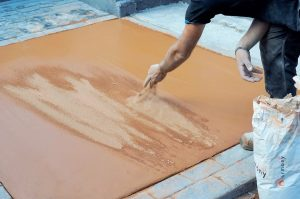
When you want to color your concrete, two methods are available to yourself:
The colorful surface hardener also called colorful quartz or
the use of pigments for a color coloring.
Le deux options pour colorer son comment teindre du beton sont possibles avec pour chacune d’elle des avantages et des inconvénients.
The colorer hardener
This is a powder made up of sand, cement, pigment and special additives.
When and how to use it?After having poured the concrete and preferably smoothed it with a smooth magnesium in order to bring up the humidity contained in it, the colored hardener will be applied at the rate of 4 to 5 kg per m2 in 2 layers in order to color inSurface concrete.
The hardener will thus absorb humidity of the concrete.It will then be smoothed to make the surface smooth and incorporate it into concrete.
Advantages: when the hardener is properly incorporated and in sufficient quantity, it strengthens the surface of the concrete by making it more dense.A denser and harder surface can help concrete better in the face of passage and alteration.
Apart from these qualities, it also allows you to easily color concrete.Thus thanks to these many shades available, a clear coloring like white is easy to obtain.
On the other hand, it is more difficult to obtain light colors during a color coloring unless to replace gray cement with white portland cement.
Note that the use of white cement will significantly increase the cost per m3 of concrete.
Due to the pigments used, some colors like the Blues and Greens are too expensive when using an integral color.These same colors are more affordable with a colored hardener.
Disadvantages: the main disadvantage of colored hardeners are that they are very dusty.On the other hand, if the slab flows, the color of the gray concrete may appear.It will still be possible to repair this by making a quartz coulis of the same color.
The coloring in the mass
The principle is that concrete is colored during its manufacture thanks to added pigments.Concrete is therefore colorful as a whole, hence the coloring name in the mass.
Advantages: the dye is mixed with concrete and therefore, this eliminates the stages of application of the colorful hardener (time saving and fatigue) and dust (cleanliness).
To this time saving, is added the fact the surface even if it flakes or wears out, the color will remain the same.
Inconvénients : Si sur le principe, la coloration de masse parait plus simple – pour colorer le béton – que celle de l’utilisation du durcisseur coloré, il apparait 2 inconvénients majeurs :
The risk of color difference between the different spoiled or concrete spinning top.Even with the greatest precaution, the risk of having differences is real.This case does not exist with the hardener.
The cost if you are looking for a light color.
In conclusion, no method for coloring a concrete is necessarily better than the other.They each have their advantages and disadvantages.




